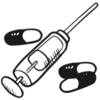
Dogs and cats love to eat things they shouldn’t. Ingesting foreign objects can be extremely dangerous. Thus, as responsible pet parents, it is our job to know what to do if it happens.
Common Foreign Objects Pets Swallow
Generally any household item within reach of your pet can be easily swallowed. This is especially true if your cat or dog is highly curious or enjoys gnawing on objects.
Dogs are the most likely to consume non-food items in most cases. Cats, on the other hand, have a proclivity to ingest string-like items. This is due to their fascination with ribbons, strings, and other dangly objects.
The following are some of the most common items that pets swallow:
- Food waste
- Bones
- Plastic items
- Small toys
- Paper
- String-like objects
- Fabric
Foreign Object Ingestion Symptoms
What happens if your pet ingests a foreign object? Foreign objects frequently obstruct your cat or dog’s gastrointestinal (GI) tract. As a result, if you suspect your cat or dog has swallowed a foreign object, look for the following symptoms:
- Diarrhoea
- Vomiting
- Lethargy
- Abdominal pain
- Excessive drooling
- Choking or gagging
- Straining to defecate
- Changes in behaviour
- Decrease in appetite as well as a refusal to eat
If your pet does not exhibit any of the following symptoms in the next few hours and has not consumed anything dangerous or harmful, they should be fine. However, it is still advisable to contact your veterinarian.
What Happens If My Pet Consumes a Foreign Object?
Different foreign objects can cause different potential effects on their gastrointestinal tract.
#1 Small Objects
Items such as a small piece of plastic from a plastic bag, a small pebble from gravel, or a scrap of paper fall into this category. These items can usually pass through your pet’s GI tract without causing major problems. However, keep in mind that this is dependent on the size of the object in comparison to the size of your pet.
#2 Large Objects
In general, large items are unsafe when swallowed. Either they choke your pet or that they become lodged elsewhere below the GI tract. This prevents food from passing through, resulting in intestinal blockage. Some examples of large items are tennis balls, dog toys, and corn cobs. Additionally, large amounts of toilet paper and silica gel packets can cause dehydration.
#3 Toxic Objects
Batteries and cigarettes are easily lodged and are highly toxic when swallowed. If a battery is chewed or punctured, it can leak caustic substances that can corrode and burn the GI tract. Cigarette consumption can also result in nicotine poisoning in cats and dogs.
#4 String-Like Objects
String-like objects can clog the small intestine. This is because one end of the string can become lodged in the stomach and the other end in the small intestine. When it bunches up, the string can cut into the small intestine, resulting in gastrointestinal perforation.
Here are the most common string-like items ingested:
- Rope toys
- Hair ties
- Ribbons
- Dental floss
- Socks
- Linen
- Bedding
- Feminine products
#5 Sharp Objects
When ingested, sharper objects are extremely dangerous. They may cut into your pet’s mouth or damage organs as they pass through the GI tract. This can result in gastrointestinal perforation. A hole in the intestines or stomach can cause fatal conditions such as sepsis or peritonitis.
As a result, we must exercise extra caution to keep our pets away from sharp objects including aluminium, sticks, broken pieces of hard plastic toys, rocks, or jewellery. It is also critical not to feed your dog cooked bones, as they can easily splinter.
How Can You Prevent It?
Prevention is always better than treatment. Thus, as a responsible pet owner, you must assist in preventing your pet from ingesting something they should not.
1. Keep rubbish bins out of your pet’s reach.
2. Keep them out of craft rooms, tool boxes or workspaces.
3. Store all strings and yarns in a pet proof container.
4. Clean up all your rubbish immediately.
5. Do not leave your pet unsupervised with their toys/chews.
6. Throw broken toys away immediately.
7. Remove non-pet toys from the floor.
8. For dogs: do not give them cooked bones.
Things to Keep in Mind
Even if you can see something stuck deep in your pet’s throat, do not pull it out (or cut it if it is a string). It is also dangerous to try to induce vomiting in your cat or dog on your own, as this can exacerbate the situation. In such cases, please take your pet to the veterinarian.
However, if your cat or dog is choking, it is critical that you act quickly. If possible, try to remove the object that has become lodged in your mouth or throat. If not, take your pet to an emergency veterinarian right away. Else, you can perform the Heimlich manoeuvre if you know how.
Heimlich Manoeuvre for Cats
- Place your cat on the side.
- Support your cat’s back with one hand.
- Use the other hand to push upwards and inwards just below the ribs.
- Finally, look inside their mouth for the displaced object.
Heimlich Manoeuvre for Small Dogs
- Place your dog on their back.
- Use your palm to apply pressure just below the rib cage, pushing inwards and upwards.
- Finally, look inside their mouth for the object that they were choking on.
Learn more about the heimlich manoeuvre for cats and small dogs by ExpertVillage Leaf Group here!
Heimlich Manoeuvre for Large Dogs
If your dog is standing:
- Put your arms around the belly so your hands clasp at the abdomen.
- Make a fist and push firmly inwards and upwards right beneath the rib cage.
- Look inside their mouth for the displaced object.
- Finally, lay your dog on their side to rest.
If your dog is lying down:
- Place one hand on your dog’s back for support.
- Use the other hand to push upwards and forwards (towards the spine) right below the ribcage.
- Finally, look inside their mouth for the displaced object.
Learn more about the heimlich manoeuvre for large dogs by HighTechPet here!
Check for a pulse if your pet is still not breathing after it has been removed. If no pulse is detected, begin CPR or artificial respiration immediately while seeking veterinary assistance. The object might have damaged your pet’s throat or mouth in the process. Hence, it is recommended to contact a vet even if the object is removed.































